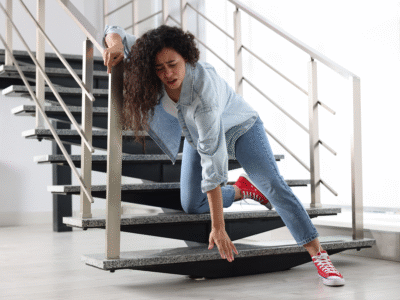
In a city like New York, surveillance cameras are nearly everywhere, from storefronts to sidewalks. As a result, video footage can be one of the most powerful tools in a premises liability claim. It can also prove invaluable if you decide to take your case to trial.
For people injured in a trip-and-fall accident, obtaining surveillance footage may be the key to securing fair compensation. At Wingate, Russotti, Shapiro, Moses & Halperin, LLP, we understand the critical role that visual evidence plays in building strong legal cases.
Why Surveillance Footage Matters in Trip-and-Fall Claims
Trip-and-fall accidents can happen in the blink of an eye. Uneven pavement, loose floor tiles, poor lighting, or unmarked hazards can easily cause a fall that leads to serious injuries.
When these incidents occur, it is essential to establish liability, and surveillance footage often provides the most compelling legal proof available.
Establishing Fault in a Premises Liability Case
In premises liability cases, the injured party must prove that the property owner or manager was negligent in maintaining a safe environment. Surveillance footage from the scene can clearly demonstrate:
- The exact location and time of the fall
- The presence of hazardous conditions (e.g., spills, debris, uneven surfaces)
- Whether staff or property owners were aware of the issue and failed to act
- The actions of the injured individual before the fall
This type of evidence can validate claims and eliminate ambiguity, making it more difficult for property owners or insurers to dispute the facts.
Capturing Events in Real Time
Unlike witness statements or post-accident photos, surveillance video captures what happened as it occurred. This can help counter false accusations, refresh fading memories, and support precise accident reconstruction.
In the fast-moving environment of NYC, where multiple parties may share responsibility for maintaining a property, clear footage can also clarify who was at fault and what steps were or were not taken to prevent the incident.
Collect Video Evidence Right Away
One of the biggest challenges in obtaining surveillance footage in trip-and-fall cases is time. Most businesses and buildings operate on limited video storage systems. Footage is often overwritten in as little as 24 to 72 hours unless a formal request is made to preserve it.
At WRSMH, we act swiftly to preserve crucial surveillance footage that may support your injury claim.
Steps to Take Immediately After an Accident
If you have been injured in a trip-and-fall accident:
- Report the Incident: Notify the property owner or manager and request a written report.
- Document the Scene: Take photographs of the location, hazards, and your injuries.
- Identify Cameras: Look for visible cameras that may have recorded the event.
- Collect Contact Info: Get names and contact details of any witnesses.
- Contact a New York City Premises Liability Lawyer: An experienced attorney can quickly send a preservation letter to request video evidence before it is lost.
Using Surveillance to Support Injury Documentation
In addition to showing how the accident occurred, video footage can also substantiate the severity of the injury. For example, it may be used to
- Show the immediate impact of the fall
- Capture the victim’s reaction or visible pain
- Record the response (or lack thereof) from on-site staff
All of this information is used alongside medical records and personal testimony to build a comprehensive picture of the event.
In cases where insurers attempt to minimize injuries or blame the victim, surveillance footage offers unbiased injury documentation that can strengthen your case.
The Legal Use of Video in Premises Liability Cases
Video evidence is admissible in New York courts and can significantly influence a jury’s perception of the case. However, there are legal procedures that must be followed to obtain and use such footage properly.
How We Obtain Surveillance Footage
Our legal team at WRSMH takes a proactive and aggressive approach to gathering video evidence. We start by identifying all potential sources of surveillance (e.g., security cameras, nearby businesses, traffic cameras). Then, we take the necessary steps to collect the video and work with investigators and video analysts to extract key moments.
Speak With Our Trusted Trip-and-Fall Lawyers in NYC
If you suffered a trip-and-fall injury in New York City, Wingate, Russotti, Shapiro, Moses & Halperin, LLP, knows how to take immediate steps to secure evidence, document injuries, and build a powerful case on your behalf.
Call us today at (212) 986-7353 to schedule a free consultation. Our trip-and-fall attorneys have won more than $2 billion for injury victims, and we’re ready to help you fight for the justice you deserve.
Surveillance Camera Video FAQs
Can surveillance footage be used as evidence in my trip-and-fall case?
Yes. Surveillance video is often one of the most powerful pieces of evidence in a trip-and-fall case. It can help establish exactly how the incident happened and whether a hazardous condition existed on the property at the time of the fall.
What if the property owner refuses to provide the video?
Property owners are not legally required to voluntarily share surveillance footage. But our legal team can issue a formal request or subpoena to obtain video evidence before it’s deleted. Acting quickly is crucial, as many surveillance systems automatically overwrite footage within days.
What if the surveillance video is missing or has been deleted?
If the footage was intentionally destroyed after the property owner was notified of a possible claim, courts may impose penalties or presume the video was unfavorable to the defense. This is known as “spoliation of evidence.”
Can video from nearby businesses or homes help my case?
Absolutely. Security cameras from neighboring buildings or public areas may have captured your fall. We act quickly to preserve all available footage that could support your injury claim.